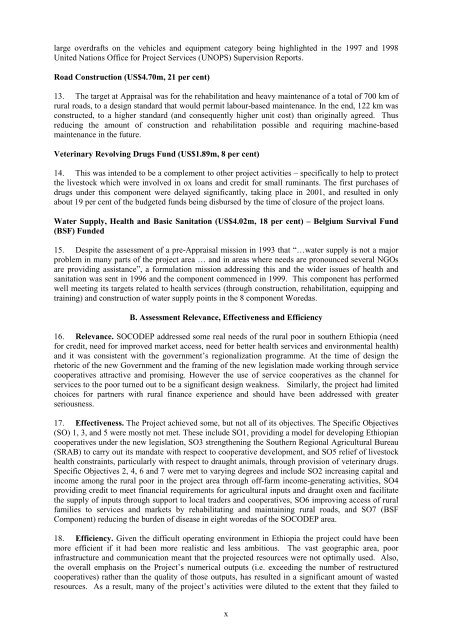Ethiopia SOCODEP CE - main report - IFAD
Ethiopia SOCODEP CE - main report - IFAD
Ethiopia SOCODEP CE - main report - IFAD
Create successful ePaper yourself
Turn your PDF publications into a flip-book with our unique Google optimized e-Paper software.
large overdrafts on the vehicles and equipment category being highlighted in the 1997 and 1998<br />
United Nations Office for Project Services (UNOPS) Supervision Reports.<br />
Road Construction (US$4.70m, 21 per cent)<br />
13. The target at Appraisal was for the rehabilitation and heavy <strong>main</strong>tenance of a total of 700 km of<br />
rural roads, to a design standard that would permit labour-based <strong>main</strong>tenance. In the end, 122 km was<br />
constructed, to a higher standard (and consequently higher unit cost) than originally agreed. Thus<br />
reducing the amount of construction and rehabilitation possible and requiring machine-based<br />
<strong>main</strong>tenance in the future.<br />
Veterinary Revolving Drugs Fund (US$1.89m, 8 per cent)<br />
14. This was intended to be a complement to other project activities – specifically to help to protect<br />
the livestock which were involved in ox loans and credit for small ruminants. The first purchases of<br />
drugs under this component were delayed significantly, taking place in 2001, and resulted in only<br />
about 19 per cent of the budgeted funds being disbursed by the time of closure of the project loans.<br />
Water Supply, Health and Basic Sanitation (US$4.02m, 18 per cent) – Belgium Survival Fund<br />
(BSF) Funded<br />
15. Despite the assessment of a pre-Appraisal mission in 1993 that “…water supply is not a major<br />
problem in many parts of the project area … and in areas where needs are pronounced several NGOs<br />
are providing assistance”, a formulation mission addressing this and the wider issues of health and<br />
sanitation was sent in 1996 and the component commenced in 1999. This component has performed<br />
well meeting its targets related to health services (through construction, rehabilitation, equipping and<br />
training) and construction of water supply points in the 8 component Woredas.<br />
B. Assessment Relevance, Effectiveness and Efficiency<br />
16. Relevance. <strong>SOCODEP</strong> addressed some real needs of the rural poor in southern <strong>Ethiopia</strong> (need<br />
for credit, need for improved market access, need for better health services and environmental health)<br />
and it was consistent with the government’s regionalization programme. At the time of design the<br />
rhetoric of the new Government and the framing of the new legislation made working through service<br />
cooperatives attractive and promising. However the use of service cooperatives as the channel for<br />
services to the poor turned out to be a significant design weakness. Similarly, the project had limited<br />
choices for partners with rural finance experience and should have been addressed with greater<br />
seriousness.<br />
17. Effectiveness. The Project achieved some, but not all of its objectives. The Specific Objectives<br />
(SO) 1, 3, and 5 were mostly not met. These include SO1, providing a model for developing <strong>Ethiopia</strong>n<br />
cooperatives under the new legislation, SO3 strengthening the Southern Regional Agricultural Bureau<br />
(SRAB) to carry out its mandate with respect to cooperative development, and SO5 relief of livestock<br />
health constraints, particularly with respect to draught animals, through provision of veterinary drugs.<br />
Specific Objectives 2, 4, 6 and 7 were met to varying degrees and include SO2 increasing capital and<br />
income among the rural poor in the project area through off-farm income-generating activities, SO4<br />
providing credit to meet financial requirements for agricultural inputs and draught oxen and facilitate<br />
the supply of inputs through support to local traders and cooperatives, SO6 improving access of rural<br />
families to services and markets by rehabilitating and <strong>main</strong>taining rural roads, and SO7 (BSF<br />
Component) reducing the burden of disease in eight woredas of the <strong>SOCODEP</strong> area.<br />
18. Efficiency. Given the difficult operating environment in <strong>Ethiopia</strong> the project could have been<br />
more efficient if it had been more realistic and less ambitious. The vast geographic area, poor<br />
infrastructure and communication meant that the projected resources were not optimally used. Also,<br />
the overall emphasis on the Project’s numerical outputs (i.e. exceeding the number of restructured<br />
cooperatives) rather than the quality of those outputs, has resulted in a significant amount of wasted<br />
resources. As a result, many of the project’s activities were diluted to the extent that they failed to<br />
x

















